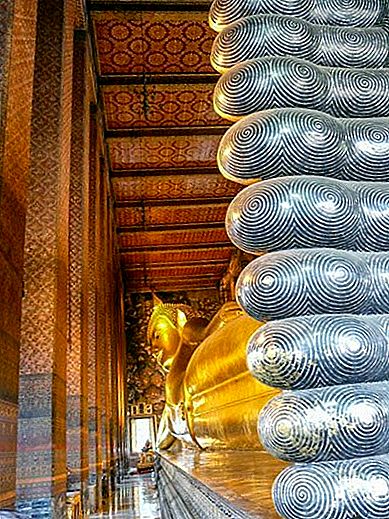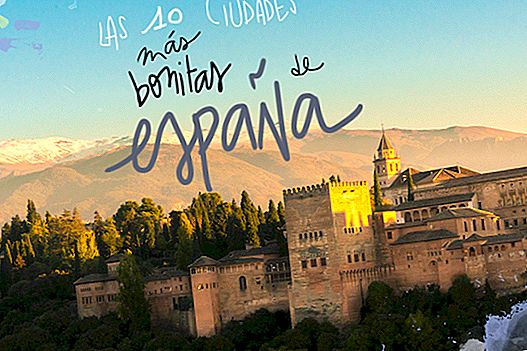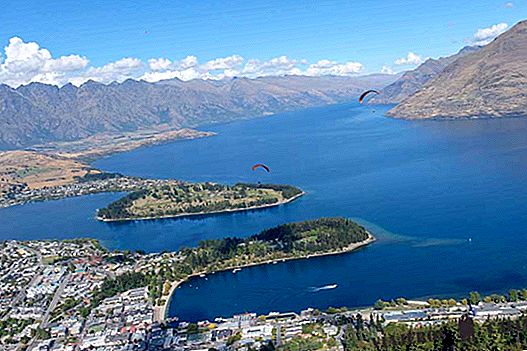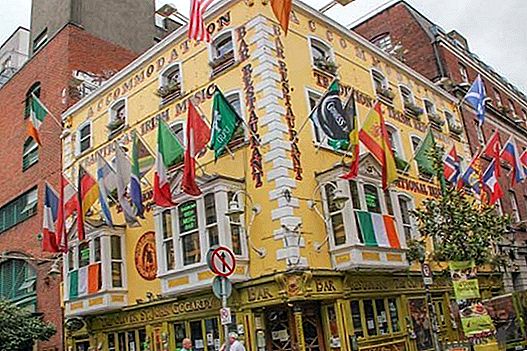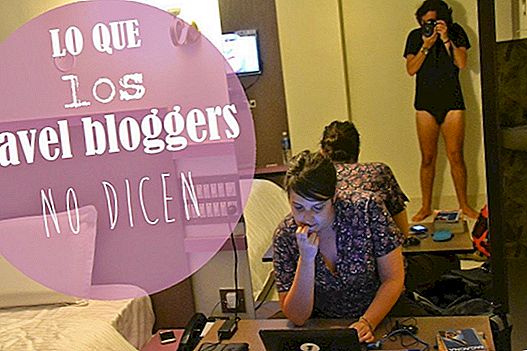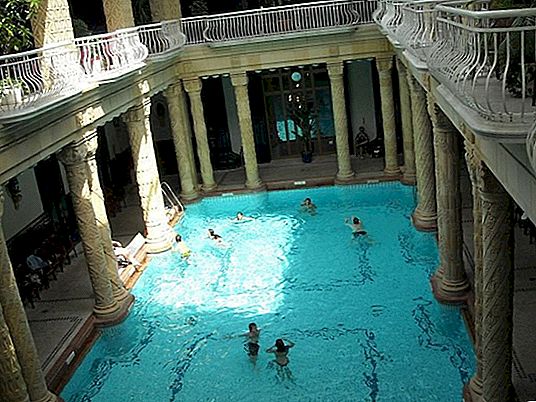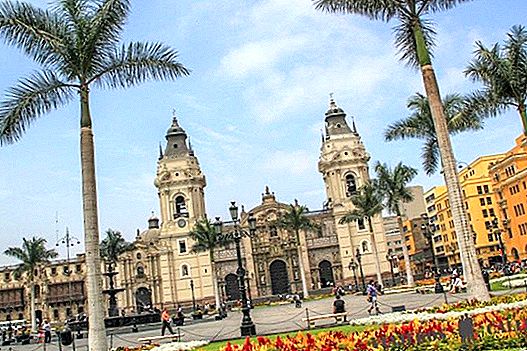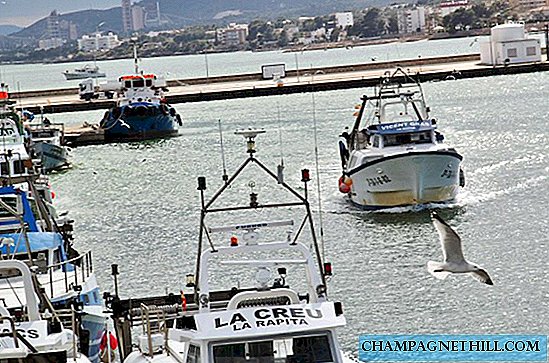Day 10: Drepung Monastery and Jokhang Monastery in Lhasa
Today our day starts at 6 in the morning, when we take the opportunity to work for a while, have a coffee in the room to charge us with energy for today that we are scheduled to visit the Drepung Monastery and the Jokhang Monastery in Lhasa and when it's 8:15 in the morning, we go up to the terrace of the Tashitakge Hotel Lhasa where, like every day since we arrived in Lhasa, we enjoyed an incredible breakfast, accompanied by the best views of the Potala Palace that we had imagined. charge energies to

Incredible views of the Potala Palace
We have met with Pasang at 9:30 in the morning to start the day with a visit to Drepung Monastery, one of the most incredible monasteries in Tibet, which we recommend you visit since it is one of the most recommended visits.
Drepung Monastery and Jokhang Monastery in Lhasa
Today's route in Lhasa will take us to two of the most incredible places in the city, the Drepung Monastery and Jokhang Monastery in Lhasa.
Drepung Monastery is 8 kilometers from Lhasa, being one of the largest and most important monasteries in the world. As we approach, Pasang gives us different details so that we can get an idea of what we are going to see and visit, explaining for example, the meaning of Drepung, which is "rice mountain" and refers to the different buildings that There are in the mountains, white and resemble rice grains.

Entrance to Drepung Monastery

Drepung Monastery
Before going through the ticket office, you pass through a large esplanade, which serves both as a parking lot, where there are also several food and beverage stores and some shops. It is worth considering if you want to buy water, since inside the Drepung Monastery there is nowhere to be able to do it.
Access to the Drepung Monastery is done by following the kora, clockwise, climbing stairs first and then a ramp, until you reach the Ganden Palace.

Details of Drepung Monastery

Drepung Monastery
The first room we find is Sanga Tratsang, where we can see a statue of the fifth Dalai Lama, surrounded by different protectors such as Namse, Chögyel and Palden Lhamo.
From here you follow the clockwise direction until you reach a main courtyard, from where you can see the main building and the different floors of the same, which can be visited.

Details Drepung Monastery
From here we follow the path, passing through the kitchen of the Drepung Monastery, where you can enter and wander through the different corridors, surrounded by pots and smells, to arrive later at the main Meeting Room, one of the most incredible we have seen until The moment on this trip to Tibet.

Main meeting room of Drepung Monastery
In this room we find several thangkas and 180 columns, which give it a really spectacular and at the same time mystical air and more when we see that several monks begin to enter, who gradually settle into their places, giving us unpayable minutes, While they sing mantras.
Without a doubt this will become one of the great moments of the trip, with many others that we are sure, we will not forget.
Inside the main meeting room we find several chapels, all of which can be visited, among which the hall of the Kings of Tibet and that of the Jampa statue, several meters high, stand out.
Always following the clockwise direction, we arrive at the Sakyamuni Chapel, with several chortens and then access the room where the sculpture of the Buddha of the Future is located, the most revered image Drepung Monastery.
From here we arrive at the Drölma Chapel, with three images of this protective goddess and several book collections.

Drepung Monastery

Memories of Drepung Monastery
In front of the main meeting room is a large esplanade, from which you have spectacular views of both Lhasa in the background, as well as the surroundings of the monastery and also, from the left side of the square, of the Drepung Monastery itself, where we can see how the different rooms are stacked on the mountain creating those rice pillars, to which the name refers.

Panoramic Drepung Monastery

Drepung Monastery

Drepung Monastery
We continue the tour of the Drepung Monastery approaching the Ngagpa School, one of the four schools that we can find in the monastery and which is dedicated to tantric study. Here we visit several chapels, including the one dedicated to Dorje Jigje, a highly revered tantric goddess.

Drepung Monastery

Drepung Monastery
We follow the pilgrimage route or kora until we reach Loseling School, the largest in Drepung Monastery, where we find, in the Main Hall, the throne used by the different Dalái Lama and several statues of different Dalái Lamas.

Drepung Monastery

Drepung Monastery
We make the next and last visit of Drepung Monastery to Deyang School, the smallest of the four, where we can see an image of Jampa in the main hall, this being the most revered of the school.
This being the last visit, from here we begin to travel the way back, entering the bowels from Drepung Monastery, touring many of its streets, which leave us and give us, probably, the best images of the monastery, since they are the ones that let us see daily life as we cross paths with monks and pilgrims.

Drepung Monastery

Drepung Monastery

Drepung Monastery
We finish the visit when it is 12:30 noon at which time we return to Lhasa, but not before making a visit to the Oracle, a visit that if you can you should not miss.
Until 1959, the first day of the year, the Dalai Lama consulted the Oracle of Nechung for all kinds of important questions. The oracle, dressed for the occasion with a headdress, so heavy, that he needed the help of several men to be able to put it on.
Remember that any foreign traveler who wants to travel to Tibet must do so through an agency (IT IS IMPOSSIBLE TO TRAVEL TO TIBET FOR FREE), either by adding to a group or privately and having, before entering Tibet, a fixed route, that the agency will have submitted and must be approved by the Chinese authorities.
To obtain the visa and all permits, it is necessary that this itinerary be approved by the authorities. It is also not possible to modify the itinerary on the fly, something very important to keep in mind, as it will force you to be clear about what you want to visit from the first moment, since based on that, the agency will manage the permits.
In our case we have traveled with The China Guide, who managed all the permits after designing a personalized itinerary together, with a guide in Spanish and that has led us to enjoy as we had never imagined this magical place.
As Pasang tells us, the oracle went into a trance, began to move at strange rates and his eyes went blank, until the moment he saw the future and with a voice full of anguish, he began to relate his visions, which They were scored.

Oracle of Nechung
After this visit, we return to Lhasa before stopping to eat at Tibetan Family Kitchen, where we were the first day we spent in Lhasa, and where we wanted to return with Pasang, since he does not know the place and we want to show it to him.
Upon our recommendation Pasang decides to listen to us and we order 3 plates of fried yak momos, more sodas for 120RMB, which we have to say are delicious again, and even Pasang approves them even saying they are "almost like the ones his mother does".

Fried yak momos in Tibetan Family Kitchen
There are a few minutes to 3 in the afternoon when we decide that the time has come to continue with the route we have scheduled for today, approaching the Jokhang Monastery in Lhasa, one of the most important places in the city, if not the most.
To get to Jokhang we have to follow Danjielin Road, until we reach the entrance of Barkhor Square, where after passing the security controls we have to go through to access this area of Lhasa, we are facing theJokhang Monastery.
The Jokhang Monastery It is the most important monastery, not only in Lhasa, but also in Tibet, where pilgrims from all corners arrive, with their prayer wheels, mantras and yak butter. An experience in itself, which you cannot miss.
In our case, we have already passed through here on several occasions, since it is one of the points that we go through when touring the Barkhor kora, but today we come from Pasang's hand to make the visit much more special. Today we will know the inside of Jokhang Monastery.
Although in the morning it is much more full of pilgrims, forming queues of several hours to access, now in the afternoon we find several organized groups and the occasional pilgrim who makes us take the visit with peace of mind, listening to all the explanations that we da Pasang, with the idea of later, when there are fewer people, return to tour all the chapels, since it is a place that deserves, at least, a couple of visits to soak up the maximum.
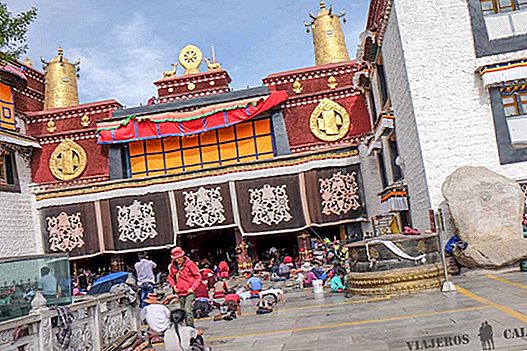
Jokhang Monastery

Pilgrims in front of Jokhang Monastery
As in the rest of the monasteries, in this one you can not take photos of the interior, so we focus on all the details and explanations, to be able to squeeze the experience to the fullest.
We pass through the entrance of Jokhang Monastery where we can see the statues of the Four Guardian Kings, typical of many monasteries, and then go to the Main Meeting Room, where we can see an outdoor patio, surrounded by frescoes.

Jokhang Monastery

Frescoes of Jokhang Monastery
We continue on the ground floor, where we can see the main prayer hall, where around it are several smaller chapels, which we travel along with the pilgrims, always clockwise, while we listen to the many explanations that Pasang is giving us, with which we managed to get closer and understand Tibetan culture much more.
Among the chapels that stand out the most are the Tsongkhapa Chapel, founder of the Gelugpa Order. The Chapel of the Eight Buddhas of Medicine, the Chenresig Chapel, with one of the most important images of the monastery and with a door that is still preserved from the origin of the Jokhang Monastery, in the 17th century.
Another of the chapels is that of the Buddha of Infinite Light, where we can see many pilgrims, which Pasang explains, ask here to see the image of Jowo Sakyamuni, the most sacred of the Jokhang Monastery, which is located in the next chapel.
This is where we stop the longest, always being as respectful as possible with the pilgrims, and where Pasang explains the history of this chapel and the image of the Sakyamuni Buddha.
From here we continue visiting the rest of the chapels, clockwise, until the last one from where we ascend to reach the first floor of the Jokhang Monastery.
On this floor of the monastery, which must also be collected clockwise, we visit several of the chapels that remain open, and that take us to the terrace of Jokhang Monastery, another of the visits you cannot leave to do, since from here it is from where you have one of the best views, both of the Barkhor Square and the Potala in the distance.

Jokhang Monastery

Barkhor Square from Jokhang Monastery

Potala from Jokhang Monastery
It's almost 5 in the afternoon when we finish the visit and it's time to say goodbye to Pasang until tomorrow, although we can't help staying at the Jokhang Monastery for a while, to finish enjoying it and it is that being such an amazing place, we find it especially difficult to leave without visiting all the chapels, now with more tranquility, since as the afternoon progresses, there are fewer organized groups, So in this second visit we do, we are the only tourists, something that allows us to take the visit with much more tranquility, being able to enjoy every detail.

Monk in Jokhang Monastery
And so we spent almost two more hours, getting lost again in the bowels of the Jokhang Monastery, for when it is almost 7 pm, go out to the streets of Barkhor, where we return to tour the area and its streets, this time without paying too much attention to the camera, dedicating ourselves only to enjoy the area and above all, the atmosphere and magic that is created in this place of Lhasa.

Barkhor from a store

Barkhor
It is 9 pm when we decide that it is time to go to dinner and being where we are, nothing better than going to Phomdha Tsang Restaurant, former home of a teacher from the current Dalái Lama, next to our accommodation, the Tashitakge Hotel Lhasa and where yesterday we had a dinner-dinner that we liked so much to return today.
On this occasion we opted to order two plates of yak steak with garnish plus two waters for 182RMB, with which we enjoyed a luxury dinner, in addition to a most pleasant table on the patio.

Yak steak
There are a few minutes to 10 when we leave the restaurant, with the firm intention of going to rest, but seeing how Barkhor is right now, which has started to get dark, we cannot resist traveling the kora again, to enjoy this moment of the day, taking us some of the most incredible images of Lhasa.

Night falls in Barkhor

Night falls in Barkhor
 Day 11: What to do in Lhasa - Best images of the Potala Palace
Day 11: What to do in Lhasa - Best images of the Potala Palace
 Remember that any foreign traveler who wants to travel to Tibet must do so through an agency (IT IS IMPOSSIBLE TO TRAVEL TO TIBET FOR FREE), either by adding to a group or privately and having, before entering Tibet, a fixed route, that the agency will have submitted and must be approved by the Chinese authorities.
Remember that any foreign traveler who wants to travel to Tibet must do so through an agency (IT IS IMPOSSIBLE TO TRAVEL TO TIBET FOR FREE), either by adding to a group or privately and having, before entering Tibet, a fixed route, that the agency will have submitted and must be approved by the Chinese authorities.